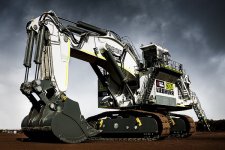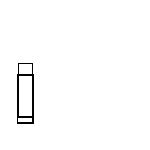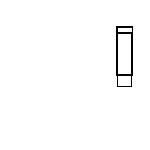You are using an out of date browser. It may not display this or other websites correctly.
You should upgrade or use an alternative browser.
You should upgrade or use an alternative browser.
Why do most tractors with FEL's.........................
- Thread starter oldpilgrim
- Start date
- Views: 21828
More options
Who Replied?
/ Why do most tractors with FEL's.........................
#51
clewis
Member
- Joined
- Oct 30, 2013
- Messages
- 27
- Location
- Dunrobin, Ontario
- Tractor
- 2010 MF GC2410 TLB, 2012 Cub Cadet LTX1146KW, 1969 Cub Cadet 127
Read up on calculating hydraulic force which takes into account piston on area. One side of the piston has less area for the oil to push against thus will have less applied from that side.
Bruce, think about it this way: cylinder extension is stronger than cylinder retraction. cylinder extension is hydro pressure on the "big face" of the piston pushing the rod out the other end, doesn't matter which way the cylinder is oriented. Retraction is weaker, because it's the "small face" of the piston.
In other words, a vertically mounted cylinder lifting a weight will generate the same lifting force, whether it's rod end up or cylinder end up. Well, except for the relative weights of the cylinder and the rod...
RLstangs
Bronze Member
That is correct. The old loaders had the lift cylinders with the rod end facing up. When you lower the loader with a load on it a vacuum is created at the rod seal and will pull in water through the seal. With the rod facing up the water runs down to the seal. I live in Minnesota and the hydraulic oil would get full of water and freeze when pushing snow. The cylinders where installed with the rod down and the water runs away from the seal. Have not had any problems since the manufacturer turned the cylinders around. Also cylinder seals are better now than 40 years ago.Bruce got it. DIRT. If the rod is on top, dirt builds up on the gland seal and it starts leaking sooner.
They've been turning cylinders upside-down on dump trailers for years. TruckPaper.com | 217 BRAZOS Half Round For Sale
http://media.sandhills.com/img.axd?...4WwNIrw6wXNaHlv8qun++PowRD11Fksw1L0iTB+5J+A3y
TMGT
Elite Member
That's why I said usually, that is a beast of a machine.Large commercial equipment seems to usually have the cylinder base closest to the valves. Less exposed lines and hoses that way. Lines and hoses farther away from something to snag them.
But you can always find exceptions:
View attachment 466901
Bruce
MossRoad
Super Moderator
- Joined
- Aug 31, 2001
- Messages
- 65,767
- Location
- South Bend, Indiana (near)
- Tractor
- Power Trac PT425 2001 Model Year
Whether the cylinder is mounted up or down, when you raise the loader bucket, the cylinder is extending, not retracting. Where's a good animated GIF of a cylinder? Some folks (me sometimes, too) need pictures.
MossRoad
Super Moderator
- Joined
- Aug 31, 2001
- Messages
- 65,767
- Location
- South Bend, Indiana (near)
- Tractor
- Power Trac PT425 2001 Model Year
MossRoad
Super Moderator
- Joined
- Aug 31, 2001
- Messages
- 65,767
- Location
- South Bend, Indiana (near)
- Tractor
- Power Trac PT425 2001 Model Year
Wow, those are some poor animations! :laughing:
LD1
Epic Contributor
I find it mind boggling that someone can think Simply turning a cylinder upside down somehow changes its extend force or speed. I understand people slip up, have a brain fart, etc. But when explained so clearly many times, and to still argue the point....:mur:
As to the original question....
I have always believed/been told that it is about hose routing. Really not anything about making it cheaper or easier. But less hose flex/movement. Keep the base of the cylinder (which remains stationary...only rotates).....and thats the end you want connected to the part the hoses are attached to.
My kubota loader has lines running down the loader. thus base end up like the pic of the mahindra. If they were reversed, and the base end were attached to the frame.....in order to have the hoses still coming from the loader, they would need to be made long enough to reach when a full loader height....then would "appear" to be way too long when lowered.
Think about a simple logsplitter. Reverse the cylinder on that (yes it will still have the same force).
But instead of the valves and hoses staying stationary, everytime you split....valve (if hooked direct to cylinder like huskee), and hoses all move back and forth with every cycle. Thus need to be made longer for full extend....and would have a mile extra when retracted.
As to the original question....
I have always believed/been told that it is about hose routing. Really not anything about making it cheaper or easier. But less hose flex/movement. Keep the base of the cylinder (which remains stationary...only rotates).....and thats the end you want connected to the part the hoses are attached to.
My kubota loader has lines running down the loader. thus base end up like the pic of the mahindra. If they were reversed, and the base end were attached to the frame.....in order to have the hoses still coming from the loader, they would need to be made long enough to reach when a full loader height....then would "appear" to be way too long when lowered.
Think about a simple logsplitter. Reverse the cylinder on that (yes it will still have the same force).
But instead of the valves and hoses staying stationary, everytime you split....valve (if hooked direct to cylinder like huskee), and hoses all move back and forth with every cycle. Thus need to be made longer for full extend....and would have a mile extra when retracted.
clewis
Member
- Joined
- Oct 30, 2013
- Messages
- 27
- Location
- Dunrobin, Ontario
- Tractor
- 2010 MF GC2410 TLB, 2012 Cub Cadet LTX1146KW, 1969 Cub Cadet 127
I think that's because the rod takes up some space but on the other side there's no rod-just a flat piston head thus giving you an inch or two more area.
It's easy to calculate. The ratio of force between extension and retraction is x:y, where x is the area of the piston face (or cylinder), and y is the area of the piston face minus the cross-section area of the rod. Or, by factoring, it's the cylinder diameter squared versus the cylinder diameter squared - the rod area squared. A 2" diameter piston and 1" rod gives a 4:3 ratio. At 1000 PSI, you get a 2*3.14*1000 extension force (about 6200 pounds), multiply that by 3:4 to get the retraction force (about 4600 pounds).
[I know just enough about hydraulics and pneumatics to get myself in trouble ;-)]
4570Man
Super Star Member
- Joined
- Apr 7, 2015
- Messages
- 18,937
- Location
- Crossville, TN
- Tractor
- Kubota M59, Kubota L3800, Grasshopper 428D, Topkick dump truck, 3500 dump truck, 10 ton trailer, more lighter trailers.
This is almost as bad as that front axle weight debate thread. How would anyone think that simply flipping a cylinder end for end would reduce its forces? Technically it would, but only by the weight of the barrel, but that's like 20 pounds on something that pushes several tons. On a side note, most wheel loaders have a lever that allows the bucket to be curled up while extending the cylinder.


